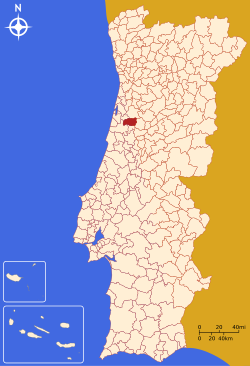Anadia Municipality, Portugal
| Anadia | ||
|---|---|---|
| Municipality | ||
|
||
 |
||
| Coordinates: 40°26′27″N 8°26′6″W / 40.44083°N 8.43500°WCoordinates: 40°26′27″N 8°26′6″W / 40.44083°N 8.43500°W | ||
| Country |
|
|
| Region | Centro | |
| Subregion | Baixo Vouga | |
| Intermunic. comm. | Região de Aveiro | |
| District | Aveiro | |
| Parishes | 10 | |
| Government | ||
| • President | Litério Augusto Marques (PSD) | |
| Area | ||
| • Total | 216.63 km2 (83.64 sq mi) | |
| Elevation | 49 m (161 ft) | |
| Population (2011) | ||
| • Total | 29,150 | |
| • Density | 130/km2 (350/sq mi) | |
| Time zone | WET/WEST (UTC+0/+1) | |
| Postal code | 3780 | |
| Area code | 231 | |
| Patron | São Paio | |
| Website | http://www.cm-anadia.pt/ | |
Anadia (Portuguese pronunciation: [ɐnɐˈði.ɐ]) is a municipality in Portugal. The population in 2011 was 29,150, in an area of 216.63 km². It had 26,915 eligible voters. The city of Anadia is part of Arcos parish. The city itself had a population of 3,034 in 2001, while Arcos parish has about 5,000.
The history of the municipality is poorly documented before the Roman era, although some vestiges of early Paleolithic (Monte Crasto, Carvalhais and Vila Nova de Monsarros), Neolithic (Moita) and Iron Age (Monte Crasto) artifacts have been studied in this area. But remnants of Roman era artifacts have been isolated in many parts of the municipality, including Aguim, Avelãs de Caminho, Avelãs de Cima, Mogofores, Moita, Óis do Bairro, São Lourenço do Bairro, Vila Nova de Monsarros, Vilarinho do Bairro and, especially, in Anadia (Monte Crasto) and Sangalhos. In addition to domestic ceramic evidence, this early villages in this area existed along the cross roads between the major Roman towns of the time: Olissipo (Lisbon) and Cale (Porto). This continues to be a source of investigation and theories as to the local importance.
Although there may have existed organized communities during this period, it was only during the Medieval Age when documentation began to appear. As such, the villages of São Lourenço do Bairro (883), Arcos (943), Sangalhos (957), Vila Nova de Monsarros (1006), Levira (1020), Vilarinho do Bairro (1020), Samel (1020), Monsarros (1064), Moita (1064), Tamengos (1064), Horta (1064), Anadia (1082), Quintela (1082), Óis do Bairro (1086), Aguim (1101), Mata (1131), Avelãs de Baixo (1132), Figueira (1138), Ferreiros (1138), Ancas (1143), Mogofores (1143), Sá (1143) and Paredes do Bairro (1143), where documented in local land registries and referenced in court records.
With about five centuries of populational existence, the area of Anadia developed over successive mutations in administrative domain. The region, during its formative age, was not developed from the implementation of forals as was the traditional method of instituting land development. But, in the historical Aveiro district on three forals were instituted to promote development: Ferreiros, Fontemanha and Vale de Avim (centers that were part of the older parish of Moita). There have been posterior references to forals conceded in this area (in Avelãs de Caminho, for example), but they were insufficiently explained to indicate that the forals were more than mere local or defensive contracts between the Crown and/or the peoples of the area. Further, there were erroneous references to older forals by contemporary authors, in particular case, the municipalities of Aguim and Anadia. At the beginning of the 16th century, during the administrative reforms of King Manuel I, the king did not forget the coastal central region, and allocated several forals. In 1514, the municipalities of Anadia, Avelãs de Cima, Vilarinho do Bairro, Carvalhais (which included Ferreiros, Fontemanha and Vale de Avim), São Lourenço do Bairro, Aguim, Sangalhos, Pereiro (the parish of Avelãs de Cima), Óis do Bairro, Mogofores, Avelãs de Caminho, Boialvo (parish of Avelãs de Cima) and Vila Nova de Monsarros; in 1519 Paredes do Bairro was granted a writ and then in 1520 forals for Mogofores and Óis do Bairro were established.
...
Wikipedia

